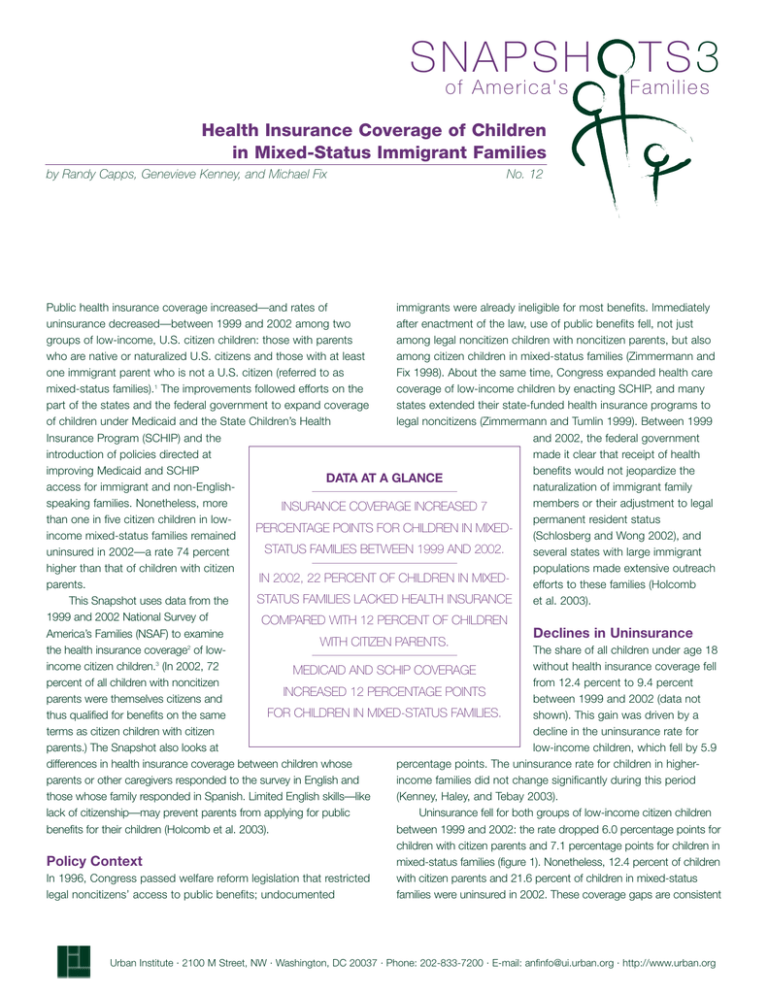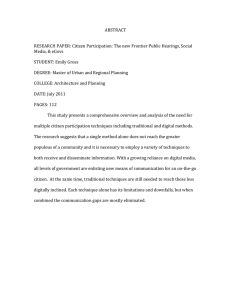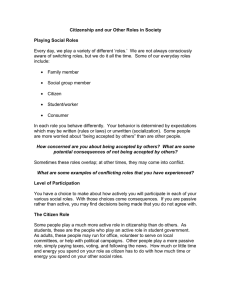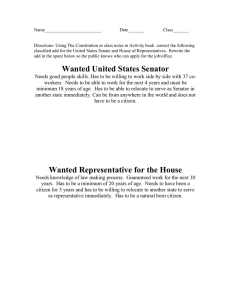3 S N A P S H ... o f A m e r i c... Health Insurance Coverage of Children
advertisement

S N A PS H o f A me r ic a' s TS3 F ami l i es Health Insurance Coverage of Children in Mixed-Status Immigrant Families by Randy Capps, Genevieve Kenney, and Michael Fix No. 12 immigrants were already ineligible for most benefits. Immediately Public health insurance coverage increased—and rates of after enactment of the law, use of public benefits fell, not just uninsurance decreased—between 1999 and 2002 among two among legal noncitizen children with noncitizen parents, but also groups of low-income, U.S. citizen children: those with parents among citizen children in mixed-status families (Zimmermann and who are native or naturalized U.S. citizens and those with at least Fix 1998). About the same time, Congress expanded health care one immigrant parent who is not a U.S. citizen (referred to as coverage of low-income children by enacting SCHIP, and many mixed-status families).1 The improvements followed efforts on the states extended their state-funded health insurance programs to part of the states and the federal government to expand coverage legal noncitizens (Zimmermann and Tumlin 1999). Between 1999 of children under Medicaid and the State Children’s Health and 2002, the federal government Insurance Program (SCHIP) and the made it clear that receipt of health introduction of policies directed at benefits would not jeopardize the improving Medicaid and SCHIP DATA AT A GLANCE naturalization of immigrant family access for immigrant and non-Englishmembers or their adjustment to legal speaking families. Nonetheless, more INSURANCE COVERAGE INCREASED 7 permanent resident status than one in five citizen children in lowPERCENTAGE POINTS FOR CHILDREN IN MIXED(Schlosberg and Wong 2002), and income mixed-status families remained STATUS FAMILIES BETWEEN 1999 AND 2002. several states with large immigrant uninsured in 2002—a rate 74 percent populations made extensive outreach higher than that of children with citizen IN 2002, 22 PERCENT OF CHILDREN IN MIXEDefforts to these families (Holcomb parents. STATUS FAMILIES LACKED HEALTH INSURANCE et al. 2003). This Snapshot uses data from the 1999 and 2002 National Survey of COMPARED WITH 12 PERCENT OF CHILDREN Declines in Uninsurance America’s Families (NSAF) to examine WITH CITIZEN PARENTS. The share of all children under age 18 the health insurance coverage2 of lowwithout health insurance coverage fell income citizen children.3 (In 2002, 72 MEDICAID AND SCHIP COVERAGE from 12.4 percent to 9.4 percent percent of all children with noncitizen INCREASED 12 PERCENTAGE POINTS between 1999 and 2002 (data not parents were themselves citizens and FOR CHILDREN IN MIXED-STATUS FAMILIES. shown). This gain was driven by a thus qualified for benefits on the same decline in the uninsurance rate for terms as citizen children with citizen low-income children, which fell by 5.9 parents.) The Snapshot also looks at percentage points. The uninsurance rate for children in higherdifferences in health insurance coverage between children whose income families did not change significantly during this period parents or other caregivers responded to the survey in English and (Kenney, Haley, and Tebay 2003). those whose family responded in Spanish. Limited English skills—like Uninsurance fell for both groups of low-income citizen children lack of citizenship—may prevent parents from applying for public between 1999 and 2002: the rate dropped 6.0 percentage points for benefits for their children (Holcomb et al. 2003). children with citizen parents and 7.1 percentage points for children in mixed-status families (figure 1). Nonetheless, 12.4 percent of children Policy Context with citizen parents and 21.6 percent of children in mixed-status In 1996, Congress passed welfare reform legislation that restricted families were uninsured in 2002. These coverage gaps are consistent legal noncitizens’ access to public benefits; undocumented Urban Institute · 2100 M Street, NW · Washington, DC 20037 · Phone: 202-833-7200 · E-mail: anfinfo@ui.urban.org · http://www.urban.org with gaps reported in a recent study based on Current Population Survey data (Ku and Waidman 2003). Improvements in coverage among low-income citizen children are attributable to expanded public—not employer—coverage. These children gained Medicaid/SCHIP coverage at high rates between 1999 and 2002: public coverage increased by 13.0 percentage points for children with citizen parents and 11.6 percentage points for children in mixed-status families (figure 2). Figure 1. Uninsurance Rates of Low-Income Citizen Children, by Citizenship of Parents, 1999 and 2002 ■ 1999 ■ 2002 25 Employer-Sponsored Insurance Children in Spanish-Speaking Families In 1999, citizen children living in low-income families that responded to the NSAF in Spanish had significantly higher health insurance coverage through Medicaid and SCHIP than their counterparts in English-speaking families (44.7 versus 36.3 percent). Children in both groups experienced equivalent gains in public coverage between 1999 and 2002 (figure 3). The higher rate of public coverage of children in Spanish-speaking families is due in part to the substantially lower rate of employer-sponsored insurance of these children. Gains in public coverage of citizen children in Spanish-speaking families are probably the result of efforts by many health and social service providers across the country to expand their Spanishspeaking staff and improve their capacity to assist Spanish speakers (Holcomb et al. 2003). Outreach for Medicaid and SCHIP was conducted in Spanish during this period, and Executive Order 13166 was issued in 2000, setting language access guidelines for federal agencies and federal aid recipients. In the absence of these outreach and language access efforts, it is unlikely that children in Spanishspeaking families would have shared as greatly in the overall gains in public coverage. 21.6ˇ 19.7 18.5 20 Percent Much of the coverage gap between the two groups of low-income citizen children stems from the significantly lower rate of employersponsored insurance among children in mixed-status families. Only 22.1 percent of those children had employer coverage in 2002, compared with 34.9 percent of children with citizen parents (figure 2). This disparity reflects the fact that immigrants are less likely than citizens to hold jobs that offer health insurance coverage (Ku and Matani 2001; Schur and Feldman 2001). Employer-sponsored coverage of low-income citizen children with citizen parents dropped 6.5 percentage points between 1999 and 2002. The already low employer coverage of children in mixedstatus families dropped 4.0 percentage points, a change that was not statistically significant.4 Urban Institute 28.7 30 13.8ˇ 15 12.4ˇ 10 5 0 All low-income citizen children Those with citizen parents Those with at least one noncitizen parent Sources: 1999 and 2002 National Survey of America's Families Notes: Low-income is defined as below 200 percent of the federal poverty thresholds. Percentage point changes are calculated from unrounded estimates for each year and may therefore differ slightly from calculations based on the rounded estimates given here. ˇ Decrease between 1999 and 2002 is significant at the 0.10 level. Discussion The findings presented here suggest several conclusions. First, the rising public coverage of citizen children in mixed-status families and in Spanish-speaking families indicates that policies designed to reduce language barriers and legal immigrants’ fears of receiving health benefits were successful during the period examined here. Second, despite these reductions in uninsurance, more than one in five low-income citizen children in mixed-status families are uninsured, compared with about one in eight children with citizen parents. Third, the very low rate of employer-sponsored coverage of children in mixed-status families indicates that further improvements in coverage of these children are likely to come from public programs. Finally, no further gains in public coverage of children in mixed-status Snapshots of America’s Families III, No. 12 families will occur—and the gains documented here may be reversed—if fiscally pressed states follow the lead of Colorado and Texas. Colorado eliminated access to Medicaid and SCHIP for most legal immigrants, both adults and children (National Immigration Law Center 2003), while Texas restricted eligibility for both native-born and immigrant children and cut funding for outreach (Center for Public Policy Priorities 2003). Figures recently released by the U.S. Census Bureau (Mills and Bhandari 2003) show no further decline in uninsurance among children between 2001 and 2002, suggesting that most of the progress we see here occurred between 1999 and 2001, and that this progress may have already ended. References Center for Public Policy Priorities. 2003. “Texas State Budget for 2004-05 and Implications for Latinos.” Presentation to National Council of La Raza, Austin, July. http://www.cppp.org/products/testimony/presentations/prs-nclr.pdf. (Accessed September 23, 2003). Fix, Michael, and Wendy Zimmermann. 2001. “All Under One Roof: MixedStatus Families in an Era of Reform.” International Migration Review 35(2): 397–419. Holcomb, Pamela, Karen Tumlin, Robin Koralek, Randy Capps, and Anita Zuberi. 2003. “The Application Process For TANF, Food Stamps, Medicaid and SCHIP.” Final Report to U.S. Department of Health and Human Services, Assistant Secretary for Policy Evaluation. Washington, D.C.: The Urban Institute. Kenney, Genevieve, Jennifer Haley, and Alexandra Tebay. 2003. “Children’s Insurance Coverage and Service Use Improve.” Snapshots of America’s Families III, No. 1. Washington, D.C.: The Urban Institute. Ku, Leighton, and Sheetal Matani. 2001. “Left Out: Immigrants’ Access to Health Care and Insurance.” Health Affairs 20(1): 247–56. Ku, Leighton, and Timothy Waidman. 2003. “How Race/Ethnicity, Immigration Status and Language Affect Health Insurance Coverage, Access to Care and Quality of Care Among the Low-Income Population.” Washington, D.C.: Kaiser Family Foundation. Mills, Robert J., and Shailesh Bhandari. 2003. “Health Insurance Coverage in the United States: 2002.” Current Population Reports. Washington, D.C.: The Census Bureau. National Immigration Law Center. 2003. “Soskin v. Reinertson: District Court Enjoins Colorado’s Termination of Immigrants’ Medicaid Eligibility.” Immigrants’ Rights Update 17(2). Los Angeles: National Immigration Law Center. Schlosberg, Claudia, and Doreena Wong. 2002. Immigrant Access to Health Benefits: A Resource Manual. Boston and Washington, D.C.: The Access Project and National Health Law Program. Schur, Claudia, and Jacob Feldman. 2001. “Running in Place: How Job Characteristics, Immigrant Status, and Family Structure Keep Hispanics Uninsured.” New York City: Commonwealth Fund and The Project HOPE Center for Health Affairs. Figure 2. Medicaid/SCHIP and Employer-Sponsored Coverage of Low-Income Citizen Children, by Citizenship of Parents, 1999 and 2002 Medicaid/SCHIP Employer-Sponsored 60 53.8ˆ 50.0ˆ 50 49.3ˆ 42.3 Percent 40 39.5 37.1 ■ 1999 ■ 2002 41.4 36.4 32.9ˇ 34.9ˇ 30 26.1 22.1 20 10 0 All low-income citizen children Those with citizen parents Those with at least one noncitizen parent All low-income citizen children Those with citizen parents Those with at least one noncitizen parent Sources: 1999 and 2002 National Survey of America's Families Notes: Low-income is defined as below 200 percent of the federal poverty thresholds. Percentage point changes are calculated from unrounded estimates for each year and may therefore differ slightly from calculations based on the rounded estimates given here. ˆ Increase between 1999 and 2002 is significant at the 0.10 level. ˇ Decrease between 1999 and 2002 is significant at the 0.10 level. Urban Institute Snapshots of America’s Families III, No. 12 Figure 3. Medicaid/SCHIP Coverage of Low-Income Citizen Children, by Language Used in Interview, 1999 and 2002 55.9ˆ 60 49.1ˆ 50 Percent 40 44.7 36.3 30 20 ■ 1999 ■ 2002 10 0 English interview Spanish interview Sources: 1999 and 2002 National Survey of America's Families of coverage. Coverage was Zimmermann, Wendy, and Michael Notes: Low-income is defined as below 200 percent of the federal measured at the time of the survey Fix. 1998. “Declining Immigrant poverty thresholds. Percentage point changes are calculated from and was grouped into four Applications for Medi-Cal and unrounded estimates for each year and may therefore differ slightly from categories: employer-sponsored Welfare Benefits in Los Angeles calculations based on the rounded estimates given here. insurance (including military County.” Immigration Studies ˆ Increase between 1999 and 2002 is significant at the 0.10 level. coverage); Medicaid, separate Research Report. Washington, SCHIP, or another state program; D.C.: The Urban Institute. other (including coverage through Zimmermann, Wendy, and Karen Medicare, privately purchased Tumlin. 1999. Patchwork coverage, and other coverage not classifiable elsewhere); and uninsurance/no Policies: State Assistance for Immigrants under Welfare Reform. Washington, coverage. Coverage is defined using a hierarchy. For example, individuals with D.C.: The Urban Institute. Assessing the New Federalism Occasional Paper both employer-sponsored and some other form of coverage were classified as No. 24. having employer-sponsored coverage. No adjustment was made for the possible undercount of Medicaid/SCHIP coverage. Acknowledgments 3 This Snapshot reports on insurance coverage of low-income citizen children The authors would like to thank Alexandra Tebay and Jane Reardon-Anderson under age 18 by the citizenship status of their parents, whereas Kenney, for their research assistance and Tim Waidman, Leighton Ku, Ken Finegold, Haley, and Tebay (2003) reported on insurance coverage of children under Alan Weil, and Stephen Zuckerman for all their good advice and comments. age 19 by family income and race/ethnicity. Parents are defined as persons age 18 and older living in the household with their biological, step-, or adoptive child under age 18. In the few cases where a parent living in the Endnotes 1 household was not identified, the respondent’s citizenship status was used. In most mixed-status families, the children are U.S. citizens but the parents 4 The 2.5 percentage point difference between the drop in employer-sponsored are not. However, many mixed-status families include both citizen and noninsurance for children of citizens and the drop for children of mixed-status citizen children (Fix and Zimmermann 2001). This Snapshot examines only families is not statistically significant at the 0.10 level. children in mixed-status families who are themselves U.S. citizens and who have at least one noncitizen parent. Additionally, by “noncitizen parents” we Randy Capps is a research associate in the Population Studies Center of the mean parents who are either legal or undocumented immigrants. Urban Institute. Genevieve Kenney is a principal research associate in the Income was obtained for the prior calendar year. Low-income families are Health Policy Center of the Urban Institute. Michael Fix is director of the defined as those with incomes below 200 percent of the federal poverty Institute’s Immigration Studies Program and a principal research associate in thresholds. 2 the Population Studies Center. The NSAF measures insurance coverage by inquiring about various sources of coverage and then asking a verification question that confirms lack of coverage Snapshots of America’s Families III, No. 12 for respondents and other household members who do not report any source Snapshots III presents findings from the 1997, 1999, and 2002 rounds of the National Survey of America’s Families (NSAF). Information on more than 100,000 people was gathered from approximately 40,000 representative households in each round. The NSAF is part of the Assessing the New Federalism project (ANF). Information on ANF and the NSAF can be obtained at http://www.urban.org/anf. SNA PSH of A me r i c a ' s TS3 Families The Assessing the New Federalism project is currently supported by The Annie E. Casey Foundation, The Robert Wood Johnson Foundation, the W.K. Kellogg Foundation, The John D. and Catherine T. MacArthur Foundation, The Ford Foundation, and The David and Lucile Packard Foundation. Alan Weil is the director of Assessing the New Federalism. Kenneth Finegold is the editor of Snapshots III. Design is by Bremmer & Goris Communications. Assessing the New Federalism An Urban Institute Program to Assess Changing Social Policies Copyright © October 2003. Permission is granted to reproduce this document with attribution to the Urban Institute. The views expressed are those of the authors and do not necessarily reflect those of the Urban Institute, its board, its sponsors, or other authors in the series.







